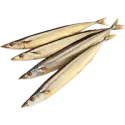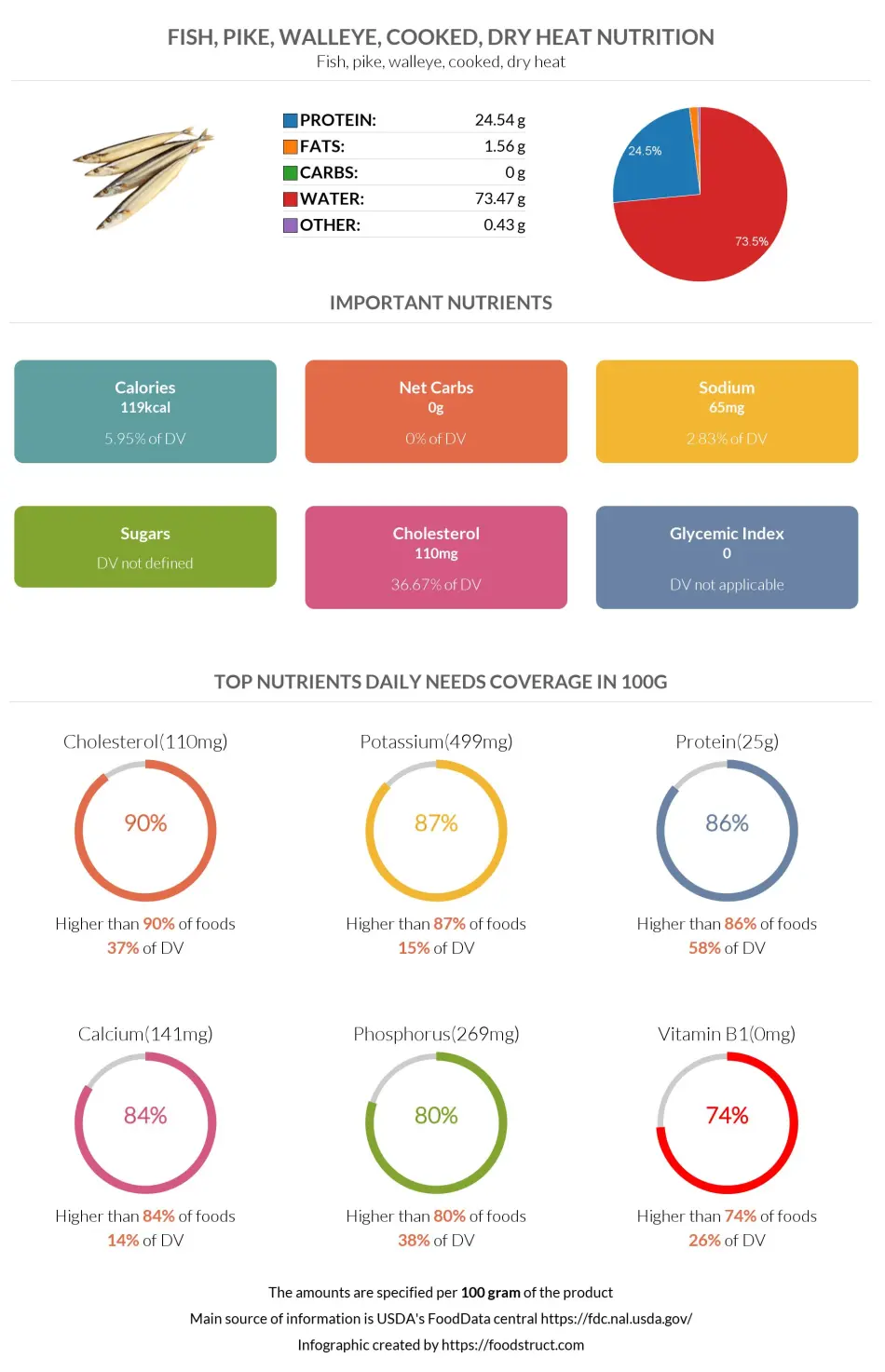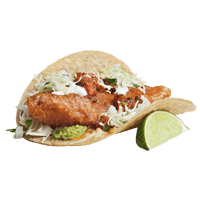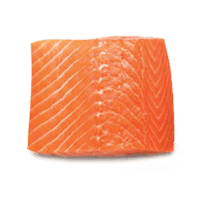Pacific saury nutrition: calories, carbs, GI, protein, fiber, fats
Fish, pike, walleye, cooked, dry heat
*all the values are displayed for the amount of 100 grams
Important nutritional characteristics for Pacific saury

| Glycemic index ⓘ Pacific saury can be considered as a 0 glycemic index food as it does not have carbs. Source: https://foodstruct.com/articles/glycemic-index-of-0-no-carb-foods | 0 (low) |
| Calories ⓘ Calories per 100-gram serving | 119 |
| Net Carbs ⓘ Net Carbs = Total Carbohydrates – Fiber – Sugar Alcohols | 0 grams |
| Serving Size ⓘ Serving sizes are taken from FDA's Reference Amounts Customarily Consumed (RACCs) | 3 oz (85 grams) |
| Acidity (Based on PRAL) ⓘ PRAL (Potential renal acid load) is calculated using a formula. On the PRAL scale the higher the positive value, the more is the acidifying effect on the body. The lower the negative value, the higher the alkalinity of the food. 0 is neutral. | 8.7 (acidic) |
| Oxalates ⓘ Animal products do not contain oxalate. | 0mg |
Cholesterol ⓘHigher in Cholesterol content than 90% of foods
Potassium ⓘHigher in Potassium content than 87% of foods
Protein ⓘHigher in Protein content than 86% of foods
Calcium ⓘHigher in Calcium content than 84% of foods
Phosphorus ⓘHigher in Phosphorus content than 80% of foods
Pacific saury calories (kcal)
| Serving Size | Calories | Weight |
|---|---|---|
| Calories in 100 grams | 119 | |
| Calories in 1 fillet | 148 | 124 g |
| Calories in 3 oz | 101 | 85 g |
Pacific saury Glycemic index (GI)
Pacific saury can be considered as a 0 glycemic index food as it does not have carbs. Source: https://foodstruct.com/articles/glycemic-index-of-0-no-carb-foods
Mineral coverage chart
Calcium:
141 mg of 1,000 mg
14%
Iron:
1.67 mg of 8 mg
21%
Magnesium:
38 mg of 420 mg
9%
Phosphorus:
269 mg of 700 mg
38%
Potassium:
499 mg of 3,400 mg
15%
Sodium:
65 mg of 2,300 mg
3%
Zinc:
0.79 mg of 11 mg
7%
Copper:
0.228 mg of 1 mg
25%
Manganese:
1.026 mg of 2 mg
45%
Selenium:
16.2 µg of 55 µg
29%
Choline:
0 mg of 550 mg
0%
Mineral chart - relative view
Potassium
499 mg
TOP 13%
Calcium
141 mg
TOP 16%
Phosphorus
269 mg
TOP 20%
Magnesium
38 mg
TOP 27%
Copper
0.228 mg
TOP 29%
Manganese
1.026 mg
TOP 32%
Iron
1.67 mg
TOP 44%
Selenium
16.2 µg
TOP 52%
Zinc
0.79 mg
TOP 59%
Sodium
65 mg
TOP 61%
Vitamin coverage chart
Vitamin A:
81 IU of 5,000 IU
2%
Vitamin E :
0 mg of 15 mg
0%
Vitamin D:
0 µg of 10 µg
0%
Vitamin C:
0 mg of 90 mg
0%
Vitamin B1:
0.312 mg of 1 mg
26%
Vitamin B2:
0.195 mg of 1 mg
15%
Vitamin B3:
2.801 mg of 16 mg
18%
Vitamin B5:
0.865 mg of 5 mg
17%
Vitamin B6:
0.138 mg of 1 mg
11%
Folate:
17 µg of 400 µg
4%
Vitamin B12:
2.31 µg of 2 µg
96%
Vitamin K:
0 µg of 120 µg
0%
Vitamin chart - relative view
Vitamin B1
0.312 mg
TOP 26%
Vitamin B12
2.31 µg
TOP 28%
Vitamin B5
0.865 mg
TOP 39%
Vitamin A
81 IU
TOP 44%
Vitamin B2
0.195 mg
TOP 47%
Folate
17 µg
TOP 51%
Vitamin B3
2.801 mg
TOP 52%
Vitamin B6
0.138 mg
TOP 57%
Vitamin C
0 mg
TOP 100%
Macronutrients chart
Protein:
Daily Value: 49%
24.54 g of 50 g
49%
Fats:
Daily Value: 2%
1.56 g of 65 g
2%
Carbs:
Daily Value: 0%
0 g of 300 g
0%
Water:
Daily Value: 4%
73.47 g of 2,000 g
4%
Other:
0.43 g
Protein quality breakdown
Tryptophan:
275 mg of 280 mg
98%
Threonine:
1076 mg of 1,050 mg
102%
Isoleucine:
1131 mg of 1,400 mg
81%
Leucine:
1994 mg of 2,730 mg
73%
Lysine:
2254 mg of 2,100 mg
107%
Methionine:
726 mg of 1,050 mg
69%
Phenylalanine:
958 mg of 1,750 mg
55%
Valine:
1264 mg of 1,820 mg
69%
Histidine:
722 mg of 700 mg
103%
Fat type information
Saturated Fat:
0.319 g
Monounsaturated Fat:
0.377 g
Polyunsaturated fat:
0.573 g
All nutrients for Pacific saury per 100g
| Nutrient | Value | DV% | In TOP % of foods | Comparison |
| Calories | 119kcal | 6% | 68% |
2.5 times more than Orange
|
| Protein | 24.54g | 58% | 14% |
8.7 times more than Broccoli
|
| Fats | 1.56g | 2% | 70% |
21.4 times less than Cheddar Cheese
|
| Vitamin C | 0mg | 0% | 100% |
N/A
|
| Net carbs | 0g | N/A | 75% |
N/A
|
| Carbs | 0g | 0% | 100% |
N/A
|
| Cholesterol | 110mg | 37% | 10% |
3.4 times less than Egg
|
| Iron | 1.67mg | 21% | 44% |
1.6 times less than Beef broiled
|
| Calcium | 141mg | 14% | 16% |
1.1 times more than Milk
|
| Potassium | 499mg | 15% | 13% |
3.4 times more than Cucumber
|
| Magnesium | 38mg | 9% | 27% |
3.7 times less than Almond
|
| Fiber | 0g | 0% | 100% |
N/A
|
| Copper | 0.23mg | 25% | 29% |
1.6 times more than Shiitake
|
| Zinc | 0.79mg | 7% | 59% |
8 times less than Beef broiled
|
| Phosphorus | 269mg | 38% | 20% |
1.5 times more than Chicken meat
|
| Sodium | 65mg | 3% | 61% |
7.5 times less than White Bread
|
| Vitamin A | 81IU | 2% | 44% |
206.2 times less than Carrot
|
| Vitamin A RAE | 24µg | 3% | 41% | |
| Selenium | 16.2µg | 29% | 52% | |
| Manganese | 1.03mg | 45% | 32% | |
| Vitamin B1 | 0.31mg | 26% | 26% |
1.2 times more than Pea raw
|
| Vitamin B2 | 0.2mg | 15% | 47% |
1.5 times more than Avocado
|
| Vitamin B3 | 2.8mg | 18% | 52% |
3.4 times less than Turkey meat
|
| Vitamin B5 | 0.87mg | 17% | 39% |
1.3 times less than Sunflower seed
|
| Vitamin B6 | 0.14mg | 11% | 57% |
1.2 times more than Oat
|
| Vitamin B12 | 2.31µg | 96% | 28% |
3.3 times more than Pork
|
| Folate | 17µg | 4% | 51% |
3.6 times less than Brussels sprout
|
| Saturated Fat | 0.32g | 2% | 73% |
18.5 times less than Beef broiled
|
| Monounsaturated Fat | 0.38g | N/A | 74% |
26 times less than Avocado
|
| Polyunsaturated fat | 0.57g | N/A | 58% |
82.3 times less than Walnut
|
| Tryptophan | 0.28mg | 0% | 53% |
1.1 times less than Chicken meat
|
| Threonine | 1.08mg | 0% | 53% |
1.5 times more than Beef broiled
|
| Isoleucine | 1.13mg | 0% | 54% |
1.2 times more than Salmon raw
|
| Leucine | 1.99mg | 0% | 54% |
1.2 times less than Tuna Bluefin
|
| Lysine | 2.25mg | 0% | 52% |
5 times more than Tofu
|
| Methionine | 0.73mg | 0% | 49% |
7.6 times more than Quinoa
|
| Phenylalanine | 0.96mg | 0% | 56% |
1.4 times more than Egg
|
| Valine | 1.26mg | 0% | 53% |
1.6 times less than Soybean raw
|
| Histidine | 0.72mg | 0% | 57% |
Equal to Turkey meat
|
| Omega-3 - EPA | 0.11g | N/A | 34% |
6.3 times less than Salmon
|
| Omega-3 - DHA | 0.29g | N/A | 34% |
5.1 times less than Salmon
|
| Omega-3 - DPA | 0.05g | N/A | 34% |
3.5 times less than Salmon
|
Check out similar food or compare with current
NUTRITION FACTS LABEL
Nutrition Facts
___servings per container
Serving Size ______________
Serving Size ______________
Amount Per 100g
Calories 119
% Daily Value*
3%
Total Fat
2g
0%
Saturated Fat 0g
37%
Cholesterol 110mg
3%
Sodium 65mg
0%
Total Carbohydrate
0g
0%
Dietary Fiber
0g
Total Sugars g
Includes ? g Added Sugars
Protein
25g
Vitamin D
0mcg
0%
Calcium
141mg
14%
Iron
2mg
25%
Potassium
499mg
15%
*
The % Daily Value (DV) tells you how much a nutrient in a serving of food contributes to a daily diet. 2,000 calories a day is used for general nutrition advice.
Health checks
Low in Cholesterol
ⓘ
Dietary cholesterol is not associated with an increased risk of coronary heart disease in healthy individuals. However, dietary cholesterol is common in foods that are high in harmful saturated fats.
Source
No Trans Fats
ⓘ
Trans fat consumption increases the risk of cardiovascular disease and mortality by negatively affecting blood lipid levels.
Source
Low in Saturated Fats
ⓘ
Saturated fat intake can raise total cholesterol and LDL (low-density lipoprotein) levels, leading to an increased risk of atherosclerosis. Dietary guidelines recommend limiting saturated fats to under 10% of calories a day.
Source
Low in Sugars
ⓘ
While the consumption of moderate amounts of added sugars is not detrimental to health, an excessive intake can increase the risk of obesity, and therefore, diabetes.
Source
Pacific saury nutrition infographic

Infographic link
References
All the values for which the sources are not specified explicitly are taken from FDA’s Food Central. The exact link to the food presented on this page can be found below.


